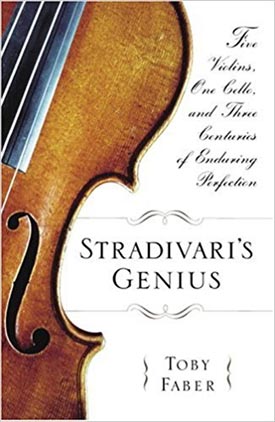 One of the most shamefully puzzling phenomena in the history of our continual technological “progress” is the simple fact that a violin maker of the late seventeenth and early eighteenth centuries manufactured instruments that no one has since been able to match, much less exceed. Toby Faber, in tracing the lives of six of Stradivari’s instruments – because, of course, it is the Strad that is the pinnacle of the luthier’s art – offers a delightfully readable and lively account of the genius of Cremona and the fascinating history of the violin.
One of the most shamefully puzzling phenomena in the history of our continual technological “progress” is the simple fact that a violin maker of the late seventeenth and early eighteenth centuries manufactured instruments that no one has since been able to match, much less exceed. Toby Faber, in tracing the lives of six of Stradivari’s instruments – because, of course, it is the Strad that is the pinnacle of the luthier’s art – offers a delightfully readable and lively account of the genius of Cremona and the fascinating history of the violin.
Faber’s book is really a romance. It is not all dry fact, but has enough basis to make his forays into speculation credible, and even sometimes reads like a fairy tale: consider the violin, in its earliest years a somewhat disreputable instrument, fit only to accompany dancing or to provide entertainments of the lower sort. (A telling glance at music and its patrons is provided by the comment of Philibert Jambe de Fer of Lyon that the harsh sound of the violin rendered it suitable only for those “few persons . . . who make a living from it through their labor.”) This Cinderella of the musical world was to prove not only the princess of the concert hall but the backbone of the modern orchestra.
We know the antecedents of the violin, in Western music the foremost of the bowed string instruments, but we don’t really know who invented it. The earliest surviving violin in the world, resident in the Ashmolean Museum in Oxford, was made by Andrea Amati of Cremona in 1564, and is the blueprint for every instrument that came after. (We can be pretty firm that Amati, himself the patriarch of a dynasty of famous violin makers, did not invent the instrument – paintings from 1535 show not only violins, but cellos, which indicates that they were already widespread, if not quite respectable.) Cremona, through the production of Amati and others, became for nearly two hundred years the center of violin making: Francesco Rugeri, Giovanni Battista Rogeri and Andrea Guarneri all apprenticed at the Amati atelier, as quite possibly did Jacob Stainer, who became Amati’s main competitor in the seventeenth century. And into this mix, from somewhere, appeared Antonio Stradivari.
There is some fairly questionable evidence that Stradivari studied at least briefly with Amati. Actually, that probably did not happen; it is much more likely that Stradivari was a woodcarver who realized that the trade of luthier was potentially much more lucrative. There is no doubt that Stradivari was a genius at working with wood: the construction and detailing of his instruments are simply amazing.
Although Stradivari is now the most widely known name in violins, it is more than a little interesting to realize that these instruments, as is often the case with the creations of genius, had to wait for the world to catch up with them. When Stradivari lived, there was very little music written for the violin, and the instrument almost never appeared solo but was rather part of a consort that played in relatively intimate spaces . Strads, with their robust and penetrating sound, were made for concert halls in a time when those concert halls simply didn’t exist. It was really in the nineteenth century that the Strad came into its own, when composers of the caliber of Beethoven, Brahms, and Tchaikovsky were writing their concerti and sonatas for violin.
Faber traces these events through the individual histories of six of Stradivari’s instruments, offering a vivid and often deliciously gossipy view not only of distinguished performers, but of the sometimes laughable, sometimes pathetic activities of heirs, dealers, performers, and later violin makers, not all of whom were necessarily scrupulous. (It is a sad but undeniable reality that dealers, who are often the foremost experts in their fields, are also often prone to asking, as Faber points out, not “what is this?” but “what can we sell this as?”) This is a romance replete with famous names, from Paganini, who amassed an astonishing collection of Strads, through Yehudi Menuhin, whose first Strad, the Khevenhüller, was a gift from financier Henry Goldman (and was later relinquished in favor of another Strad, the Soil), to Jacqueline du Prê for whom her Stradivarius cello, the famed Davidov, was simply the wrong instrument. (One learns, among other tidbits, that the Viotti/Marie Hall was actually two different instruments, although Hall herself believed that she owned the Viotti, and that somehow, miraculously, no Strads are known to have been destroyed in World War II. And, yes, Strads have names: they are that individual.)
There is, however, much more to this book than romance: beginning with some solid history, and working its way through an eminently readable portrayal of the technical aspects of violin construction, Stradivari’s Genius offers an entertaining and thoughtful essay on genius and its legacy, with lively side trips through the foibles of the musical world.
(Random House, 2004)
